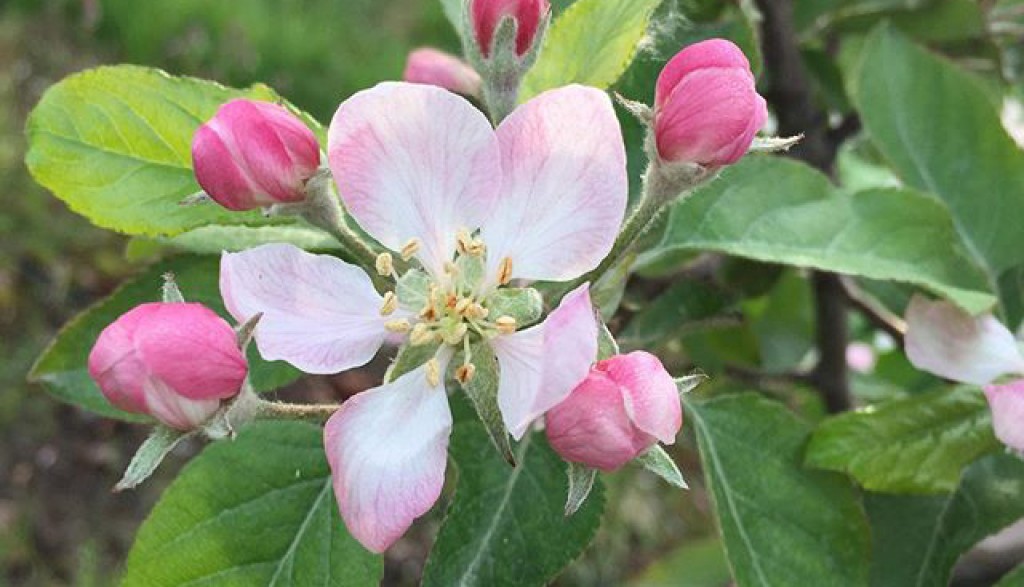Notes from the Orchard: Bloom Season in Michigan
If you caught our Instagram lately, you were treated to a behind-the-scenes adventure in springtime orchards with Elizabeth Wittenbach, a fifth-generation apple, field corn and soybean farmer based in Belding, Michigan. The Wittenbach’s family farm operation includes Elizabeth and her father, Mike, and grandfather, Ed. From King Blooms to fire blight protection, springtime for Michigan apple growers means setting up for a healthy growing season and preparing for any unexpected emergencies that could spell trouble for the fragile blooms. Elizabeth shared more insights into the stresses and successes that define springtime for apple growers in humid west-central Michigan.
Planting
Before the bloom comes the planting, naturally. As of mid-April, the rainy conditions mean the Wittenbachs have finished about a third of their planting. Trying to get it done in the rain can be counterproductive with the messy ground. A trellis system is added several weeks later, after the bloom—though many orchards do this simultaneously with planting. Planting in the Wittenbach Orchards is done with a tractor to ensure the rows are straight, and crab apple trees planted within each block for cross-pollination purposes.
Frost
With its lingering winter, Michigan tends to bloom slightly later than many other apple-growing states that are further south, like Virginia. Low temperatures during bloom present a significant challenge.
“That’s where you risk getting dead buds depending on the growth stage,” says Wittenbach. The Wittenbachs run frost fans on cold nights. Before the blooms open, chillier temperatures (even in the teens) are survivable. At full bloom, temperatures in the low thirties can be a problem.
So, it can be a good thing if the blooms don’t come early—which leaves them vulnerable to fluctuating spring temperatures. In 2012, an early warmup followed by a major drop-off in temperature meant that the blooms came early—before the warm temperatures could be sustained—leaving the blooms vulnerable to a freeze. Most years, blooms arrive by Mother’s Day. Some varieties tend to bloom before others. For example, Smitten often open before Fuji.
Disease & Insect Protection
What makes the blooms so fragile? Whenever there’s an open bloom, there’s an opening into the tree that leaves it vulnerable to devastating diseases like fire blight and apple scab.
“Warm, wet conditions around bloom can create a bacteria population that moves into the tree,” Wittenbach explains. “If there’s a chance of infection, you have to spray to prevent it. If there’s a huge wind or hailstorm, torn leaves, breakage, that’s a dangerous opening that bacteria could move into.”
Predictions that direct preventive measures are generally based on temperature, but the extension with Michigan State University offers models online and weekly discussions with extension educators to help growers know when to step in, or how many more hours of cold or rain would lead to apple scab or fire blight conditions.
“With fire blight, sometimes a perfect storm of infection factors might happen, but you have to constantly be ready to act.” Whenever warm, wet conditions and open blooms are involved, being prepared to intervene to ensure that the blooms can be saved is critical.
And of course, when you are dealing with something as unpredictable as the weather, the feeling of being on standby lasts throughout the weeks-long bloom period. “Sometimes spray decisions are made an hour or two in advance.” Wind also plays a factor—waiting for it to die down is critical to ensure the spray is effective.
In April, they also work to protect from apple scab infection. “Scab spray covers the whole farm by driving alternate middles (every other row) spraying the outside or inside. We do one side of the whole farm, ask if we need a full cover, or do the outside side, and then wait a day or two and do the other side for the full cover. We run three sprayers on our operation with radios and check off all the different blocks among our team,” says Wittenbach.
“With spraying, it goes by block, and then variety.” Some apple varieties are less susceptible, like Honeycrisp, for example, though they all end up with proper protection.
Other insect pressures take their turn throughout bloom and growing season, and the Wittenbachs prepare to protect their orchards accordingly. Codling moths are most commonly seen in mid-May, and obliquebanded leafrollers in June. The Wittenbachs start with trapping and tracking insects to identify how to spray and treat apple trees to protect them from one or more generations of insects.
“They’ll be laying their eggs, and we try to take them out then,” says Wittenbach. “We look at when the flight is. Later in the year, we look at whether we have to take out a second generation, and if they need a more aggressive approach.” Sometimes, to prevent the second generation from reproducing, the Wittenbachs use mating disruption by spreading the female pheromones. Because the scent is so prevalent to the males, they are unable to find the females for mating. Some operations use this technique throughout the year.
Pollination
Apple trees need to be cross-pollinated—meaning trees of a particular variety have to be fertilized with pollen from a different variety, or a crabapple tree. Trees pollinated by the same variety won’t bear fruit.
On a cluster of apple blossoms, the king bloom is the one that opens first, and one apple will grow per cluster. The goal is to get that bloom cross-pollinated as soon as possible—but not the rest of the blooms in that cluster or the other blooms would need to be thinned out later. While thinning can be a stressful process too, it’s not nearly as stressful as the weather-dependent and delicate bloom state with the risks of scab, blight, or frost events that could happen.
Rather than mixing varieties throughout the orchards, which becomes complicated around harvest time, the Wittenbachs mix in crabapple trees throughout the orchards for cross-pollination. They are staggered among the rows, about every thirty trees or so.
Rush to Market
Despite a week’s delay in bloom this year, Michigan apples are likely to catch up by harvest time. Wittenbach explains that they tend to make up time throughout the summer and will begin harvesting mid-August. They continually look at adding new or more early-harvest varieties, like Honeycrisp. Being among the first of the season’s fresh apples to market offers a definite advantage from a retail perspective.
Once the turbulent fluctuations and stress of bloom are over, summer offers smoother sailing, Wittenbach shares in closing. “If you survive the major infections of scab, blight, frost events, you’re great. Summer is much easier.”








